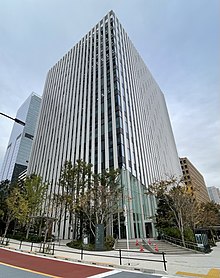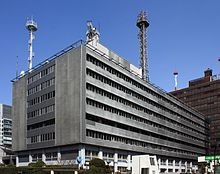Japan Meteorological Agency
This article contains content that is written like an advertisement. (August 2020) |
| Kishō-chō (気象庁) | |
 JMA logo | |
 JMA headquarters building in Tokyo | |
| Agency overview | |
|---|---|
| Formed | July 1, 1956 |
| Preceding agencies |
|
| Jurisdiction | Government of Japan |
| Headquarters | 3-6-9 Toranomon, Minato City, Tokyo, Japan 35°39′57″N 139°44′45″E / 35.66583°N 139.74583°E |
| Employees | 5,539 (2010)[1] |
| Annual budget | ¥62.0 billion (2010–11)[2] ¥59.0 billion (2011–12)[3] ¥58.9 billion (est. 2012)[3] |
| Agency executives |
|
| Parent agency | Ministry of Land, Infrastructure, Transport and Tourism |
| Website | jma.go.jp |
The Japan Meteorological Agency (気象庁, Kishō-chō), abbreviated JMA, is an
JMA is responsible for gathering and reporting weather data and
History
Meteorological organizations in Japan have their origins in the 1870s, when the first weather stations started being established in the country.
Timeline
This section may need to be rewritten to comply with Wikipedia's quality standards. (February 2023) |

- August 26, 1872 – The first weather station in Japan was set up in
- June 1875 – The original Tokyo Meteorological Observatory (東京気象台, Tōkyō Kishō-dai) was formed within the Survey Division of the Geography Bureau of the
- January 1, 1887 – The Tokyo Meteorological Observatory was renamed as the Central Meteorological Observatory (中央気象台, Chūō Kishō-dai), with the transfer of its jurisdiction to the Home Ministry.
- April 1895 – The Ministry of Education (文部省, Monbushō) replaced the preceding ministry as an administrator of the Observatory.
- January 1, 1923 – The main office was moved to Motoe-machi, Kōjimachi-ku (later Takehira-chō 1). it is located near a moat surrounding the Imperial Palace.[7]
- November 1943 – The Ministry of Transport and Communications (運輸通信省, Un'yu Tūshin-shō) took over Central Meteorological Observatory operation.
- May 1945 – JMA became part of the Ministry of Transport (運輸省, Un'yu-shō).
- July 1, 1956 – The Central Meteorological Observatory became an agency of the Ministry of Transport, and has been renamed to the Japan Meteorological Agency (気象庁, Kishō-chō).
- March 1964 – The headquarters office was relocated to Ōtemachi, Chiyoda-ku.
- January 6, 2001 – The JMA became an agency of the Ministry of Land, Infrastructure, Transport and Tourism (国土交通省, Kokudo-kōtsū-shō) with the Japanese government reformation.
- 2013 – It was announced that it would be scheduled to move the headquarters into
- November 24, 2020 - JMA moved to its new headquarters in Toranomon, Minato-ku.[6]
Services
Overview
The JMA is responsible for observing, gathering and reporting weather data and
The agency has six regional administrative offices (including five
In 1968, the World Meteorological Organization (WMO) designated the JMA as a Regional Specialized Meteorological Centre (RSMC) for Asia.[9] In June 1988, the WMO also assigned the JMA as a RSMC for the Northwestern Pacific under its Tropical Cyclone programme.[9] In July 1989, the RSMC Tokyo – Typhoon Center was established within the headquarters office, which dealt with the forecasting and dissemination of active tropical cyclones, as well as preparing a summary of each year's cyclone activity.[10]
Observation and forecast
This section needs expansion. You can help by adding to it. (March 2012) |
Weather
Land weather
Each
Marine weather
The Marine Observatories are seated in
Aviation weather
In 2005, in accordance with the
The agency forecasts
.Tropical cyclones
In the Northwestern Pacific area, the typhoon season ordinarily comes almost from May to November. The JMA forecasts and warns or advises on tropical cyclones to the public in Japan and its surrounding countries as the RSMC Tokyo – Typhoon Center.[11]
Earthquakes
The JMA has 624 observation stations across Japan
The agency is one of the representatives of the national Coordinating Committee for Earthquake Prediction.[15]
Tsunamis
In case of a possibility of tsunami after an earthquake, JMA issues Tsunami Warning or Advisory for each region in Japan with information of estimated tsunami heights and arrival times within 2 to 3 minutes of the quake.
Volcanoes
The agency four
Organization
Headquarters
- JMA Headquarters (気象庁本庁, Kishō-chō Honchō)
- Director-General (長官, Chōkan)
- Deputy Director-General (次長, Jichō)
- Deputy Director-General for Disaster Mitigation (気象防災監, Kishō-Bousaikan)
- Administration Department (総務部, Sōmu-bu)
- Counselors (参事官, Sanjikan)
- Information Infrastructure Department (情報基盤部, Johō-kiban-bu)
- Atmosphere and Ocean Department (大気海洋部, Taiki-kaiyō-bu)
- Seismology and Volcanology Department (地震火山部, Jishin-kazan-bu)
- Administration Department (総務部, Sōmu-bu)
Local offices
- Local Offices (地方支分部局, Chihō Shibun Bukyoku)
- 6 Regional Headquarters
- Sapporo Regional Headquarters (札幌管区気象台, Sapporo Kanku Kishō-dai)
- 6 Local Meteorological Observatories (地方気象台, Chihō Kishō-dai)
- 1 Weather Station(測候所, Sokkōjo)
- 1 Aviation Weather Station (航空測候所, Kōkū Sokkōjo)
- Sendai Regional Headquarters (仙台管区気象台, Sendai Kanku Kishō-dai)
- 5 Local Meteorological Observatories (地方気象台, Chihō Kishō-dai)
- 1 Aviation Weather Station (航空測候所, Kōkū Sokkōjo)
- Tokyo Regional Headquarters (東京管区気象台, Tokyo Kanku Kishō-dai)
- 16 Local Meteorological Observatories (地方気象台, Chihō Kishō-dai)
- 3 Aviation Weather Service Centers (航空地方気象台, Kōkū Chihō Kisyō-dai)
- Osaka Regional Headquarters (大阪管区気象台, Osaka Kanku Kishō-dai)
- 13 Local Meteorological Observatories (地方気象台, Chihō Kishō-dai)
- 1 Aviation Weather Service Center (航空地方気象台, Kōkū Chihō Kisyō-dai)
- Fukuoka Regional Headquarters (福岡管区気象台, Fukuoka Kanku Kishō-dai)
- 7 Local Meteorological Observatories (地方気象台, Chihō Kishō-dai)
- 1 Weather Station(測候所, Sokkōjo)
- 1 Aviation Weather Service Center (航空地方気象台, Kōkū Chihō Kisyō-dai)
- Okinawa Regional Headquarters (沖縄気象台, Okinawa Kishō-dai)
- 3 Local Meteorological Observatories (地方気象台, Chihō Kishō-dai)
- 1 Aviation Weather Station (航空測候所, Kōkū Sokkōjo)
- Sapporo Regional Headquarters (札幌管区気象台, Sapporo Kanku Kishō-dai)
- 6 Regional Headquarters
Auxiliary organs
- Auxiliary Organs(施設等機関, Shisetsu-tō Kikan)
- Meteorological Research Institute (気象研究所, Kishō Kenkyūjo)
- Meteorological Satellite Center (気象衛星センター, Kishō-eisei Sentā)
- Aerological Observatory (高層気象台, Kōsō Kishō-dai)
- Magnetic Observatory (地磁気観測所, Chijiki Kansokujo)
- Meteorological College (気象大学校, Kishō Daigakkō)
Directors-General and Chief Executives
Chief Executives of Central Meteorological Observatory
- Arai Ikunosuke (荒井 郁之助): 1890–1891
- Kobayashi Kazutomo (小林 一知): 1891–1895
- Nakamura Kiyoo (中村 精男): 1895–1923
- Okada Takematsu (岡田 武松): 1923–1941
- Fujiwhara Sakuhei (藤原 咲平): 1941–1947
- Wadachi Kiyoo (和達 清夫): 1947–1956
Directors-General of JMA
- Wadachi Kiyoo (和達 清夫): 1956–1963
- Hatakeyama Hisanao (畠山 久尚): 1963–1965
- Shibata Yoshiji (柴田 淑次): 1965–1969
- Yoshitake Motoji (吉武 素二): 1969–1971
- Takahashi Koūchirō (高橋 浩一郎): 1971–1974
- Mouri Keitarō (毛利 圭太郎): 1974–1976
- Arizumi Naosuke (有住 直介): 1976–1978
- Kubota Masaya (窪田 正八): 1978–1980
- Masuzawa Jōtarō (増澤 譲太郎): 1980–1983
- Suehiro Shigeji (末廣 重二): 1983–1985
- Uchida Eiji (内田 英治): 1985–1987
- Kikuchi Yukio (菊地 幸雄): 1987–1990
- Tatehira Ryōzō (立平 良三): 1990–1992
- Nitta Takashi (新田 尚): 1992–1993
- Ninomiya Kōzō (二宮 洸三): 1993–1996
- Ono Toshiyuki (小野 俊行): 1996–1998
- Takigawa Yūsō (瀧川 雄壮): 1998–2000
- Yamamoto Kōji (山本 孝二): 2000–2003
- Kitade Takeo (北出 武夫): 2003–2004
- Nagasaka Kōichi (長坂 昴一): 2004–2006
- Hiraki Satoshi (平木 哲): 2006–2009
- Sakurai Kunio (櫻井 邦雄): 2009–2011
- Hatori Mitsuhiko (羽鳥 光彦): 2011–2014
- Nishide Noritake (西出 則武): 2014–2016
- Hashida Toshihiko (橋田 俊彦): 2016–2019
- Sekita Yasuo (関田 康雄): 2019–2021
- Hasegawa Naoyuki (長谷川直之): 2021-present
See also
References
- ^ a b c d e 総合パンフレット「気象庁」 (PDF) (in Japanese). Japan Meteorological Agency. January 2011. Archived from the original (PDF) on March 31, 2012. Retrieved April 1, 2012.
- ^ 平成23年度 気象庁関係予算決定概要 (PDF) (in Japanese). Japan Meteorological Agency. December 24, 2010. Retrieved April 1, 2012.
- ^ a b 平成24年度 気象庁関係予算決定概要 (PDF) (in Japanese). Japan Meteorological Agency. December 24, 2011. Retrieved April 1, 2012.
- ^ "国土交通省設置法 (e-Gov)" (in Japanese). 総務省. Archived from the original on February 15, 2012. Retrieved March 31, 2012.
- ^ a b Kan'ichi Koinuma (March 1969). 内務省における気象観測の開始の経緯と気象台の名称 (PDF) (in Japanese). Meteorological Society of Japan. Retrieved March 30, 2012.
- ^ a b "Access to JMA Headquarters". Japan Meteorological Agency. November 24, 2020. Retrieved December 10, 2020.
JMA Headquarters moved on 24 November 2020.
- ^ a b 気象庁庁舎移転後の新しい露場を選定 (PDF) (in Japanese). Japan Meteorological Agency. September 2008. Archived from the original (PDF) on May 14, 2012. Retrieved March 30, 2012.
- ^ a b "Japan Meteorological Agency: The national meteorological service of Japan" (PDF). Japan Meteorological Agency. Archived from the original (PDF) on January 13, 2012. Retrieved February 7, 2011.
- ^ a b "Cooperation through WMO and Other Multilateral Activities". Japan Meteorological Agency. Retrieved April 3, 2012.
- ^ Japan Meteorological Organization (February 2001). "Annual Report on Activities of the RSMC Tokyo – Typhoon Center 2000" (PDF). Retrieved November 21, 2011.
- ^ RSMC Tokyo – Typhoon Center
- ^ a b "Table of Observation Stations" (PDF). The Headquarters for Earthquake Research Promotion (of Japan). September 2011. Retrieved April 2, 2012.
- ISBN 978-3-540-67962-2.
- Japan Times. p. 7. Retrieved March 31, 2012.
- ^ "Organizations with ties to CCEP". CCEP. Retrieved March 19, 2011.
External links
- JMA – official website
- Northwest Pacific Tsunami Advisory Center (NWPTAC) (archived 15 April 2012)
